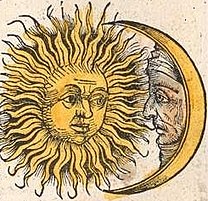Մասնակից:Moon0110/Ավազարկղ1
Օր, Ժամանակի չափման միավոր, մոտավորապես հավասար է Երկիր մոլորակի իր առանցքի շուրջ մեկ պտույտի պարբերությանը[1][2]։ Սովորաբար «օր» ասելով հասկանում են «արևային օր» աստղագիտական հասկացությունը։ Օրը բաժանվում է 24 ժամի (1440 րոպե, կամ 86400 վայրկյան) և կազմված է առավոտ, կեսօր, երեկո և գիշեր մասերից։ Օրացուցային օրերը կազմում են շաբաթներ, ամիսներ, տարիներ։
1900 թվականին վայրկյանը վերագրվեց Երկրի ուղեծրի շարժը բնութագրող տերմինների շարքին, իսկ 1960 թվականին ՄՀ-ում սահմանվեց որպես ժամանակի հիմնական միավոր։ Օրը որպես չափման միավոր ներկայացվում է 86,400 ՄՀ վայրկյանով և նշանկվում՝ «օր»։ 1967 թվականին վայրկայնը և օրը վերագրվեցին ատոմի ներսում էլեկտրոնի անցմանը։[3] Սովորաբար օրը բաղկացած է 86,400 վայրկյանից, գումարած կամ հանած Համաշխարհային կոորդինացված ժամանակի հավանական հավելյալ վայրկյանները և երբեմն գումարվում կամ հանվում է նաև մեկ ժամ այն տեղանքների դեպքում, որոնք ամառային ժամանակի անցնելիս փոփխվում են։
Մեկ օրը կարելի է բաժանել նաև 24 ժամերի՝ հաշվարկված կեսգիշերից սկսած մինչև հաջորդ կեսգիշեր, որոնք էլ կազմում են շաբաթ, ամիս կամ տարի, և համապատասխանում է Երկրի իր առանցքի շուրջը պտույտին:[4] Այնուամենայնիվ դրանց օգտագործումը կախված է խոսքի բովանդակությունից, օրինակ՝ երբ ասվում է «օր ու գիշեր», «օրը» արտահայտում է այլ իմաստ։ Տվյալ պարագայում այն նշանակում է ցերեկվա տևողությունը երկու իրար հաջորդող գիշերներում։
However its use depends on its context, for example when people say 'day and night', 'day' will have a different meaning. It will mean the interval of light between two successive nights; the time between sunrise and sunset.[5] People tend to sleep during the night and are awake at a day, in this instance 'day' will mean time of light between one night and the next.[6] However, in order to be clear when using 'day' in that sense, "daytime" should be used to distinguish it from "day" referring to a 24-hour period[7]; this is since daytime typically always means 'the time of the day between sunrise and sunset.[8] The word day may also refer to a day of the week or to a calendar date, as in answer to the question, "On which day?" The life patterns (circadian rhythms) of humans and many other species are related to Earth's solar day and the day-night cycle.

Introduction
[խմբագրել | խմբագրել կոդը]
Apparent and mean solar day
[խմբագրել | խմբագրել կոդը]Several definitions of this universal human concept are used according to context, need and convenience. Besides the day of 24 hours (86 400 seconds), the word day is used for several different spans of time based on the rotation of the Earth around its axis. An important one is the solar day, defined as the time it takes for the Sun to return to its culmination point (its highest point in the sky). Because celestial orbits are not perfectly circular, and thus objects travel at different speeds at various positions in their orbit, a solar day is not the same length of time throughout the orbital year. Because the Earth orbits the Sun elliptically as the Earth spins on an inclined axis, this period can be up to 7.9 seconds more than (or less than) 24 hours. In recent decades, the average length of a solar day on Earth has been about 86 400.002 seconds[9] (24.000 000 6 hours) and there are about 365.2422 solar days in one mean tropical year.
Ancient custom has a new day start at either the rising or setting of the Sun on the local horizon (Italian reckoning, for example, being 24 hours from sunset, oldstyle).[10] The exact moment of, and the interval between, two sunrises or sunsets depends on the geographical position (longitude as well as latitude), and the time of year (as indicated by ancient hemispherical sundials).
A more constant day can be defined by the Sun passing through the local meridian, which happens at local noon (upper culmination) or midnight (lower culmination). The exact moment is dependent on the geographical longitude, and to a lesser extent on the time of the year. The length of such a day is nearly constant (24 hours ± 30 seconds). This is the time as indicated by modern sundials.
A further improvement defines a fictitious mean Sun that moves with constant speed along the celestial equator; the speed is the same as the average speed of the real Sun, but this removes the variation over a year as the Earth moves along its orbit around the Sun (due to both its velocity and its axial tilt).
Stellar day
[խմբագրել | խմբագրել կոդը]A day, understood as the span of time it takes for the Earth to make one entire rotation[11] with respect to the celestial background or a distant star (assumed to be fixed), is called a stellar day. This period of rotation is about 4 minutes less than 24 hours (23 hours 56 minutes and 4.1 seconds) and there are about 366.2422 stellar days in one mean tropical year (one stellar day more than the number of solar days). Other planets and moons have stellar and solar days of different lengths from Earth's.
Daytime
[խմբագրել | խմբագրել կոդը]A day, in the sense of daytime that is distinguished from night-time, is commonly defined as the period during which sunlight directly reaches the ground, assuming that there are no local obstacles. The length of daytime averages slightly more than half of the 24-hour day. Two effects make daytime on average longer than nights. The Sun is not a point, but has an apparent size of about 32 minutes of arc. Additionally, the atmosphere refracts sunlight in such a way that some of it reaches the ground even when the Sun is below the horizon by about 34 minutes of arc. So the first light reaches the ground when the centre of the Sun is still below the horizon by about 50 minutes of arc[12]. Thus, daytime is on average around 7 minutes longer than 12 hours[13].
Etymology
[խմբագրել | խմբագրել կոդը]The term comes from the Old English dæg, with its cognates such as dagur in Icelandic, Tag in German, and dag in Norwegian, Danish, Swedish and Dutch. All of them from the Indo-European root dyau which explains the similarity with Latin dies though the word is known to come from the Germanic branch. As of Հոկտեմբերի 17, 2015[update], day is the 205th most common word in US English,[14] and the 210th most common in UK English.[14]
International System of Units (SI)
[խմբագրել | խմբագրել կոդը]A day, symbol d, defined as 86 400 seconds, is not an SI unit, but is accepted for use with SI.[15] The Second is the base unit of time in SI units.
In 1967–68, during the 13th CGPM (Resolution 1),[16] the International Bureau of Weights and Measures (BIPM) redefined a second as
… the duration of 9 192 631 770 periods of the radiation corresponding to the transition between two hyperfine levels of the ground state of the caesium 133 atom.[17]
This makes the SI-based day last exactly 794 243 384 928 000 of those periods.
Leap seconds
[խմբագրել | խմբագրել կոդը]Mainly due to tidal effects, the Earth's rotational period is not constant, resulting in minor variations for both solar days and stellar "days". The Earth's day has increased in length over time. This phenomenon is due to tides raised by the Moon which slow Earth's rotation. Because of the way the second is defined, the mean length of a day is now about 86 400.002 seconds, and is increasing by about 1.7 milliseconds per century (an average over the last 2 700 years). (See tidal acceleration for details.) The length of a day circa 620 million years ago has been estimated from rhythmites (alternating layers in sandstone) as having been about 21.9 hours. The length of day for the Earth before the moon was created is still unknown.[փա՞ստ]
In order to keep the civil day aligned with the apparent movement of the Sun, a day according to Coordinated Universal Time (UTC) can include a negative or positive leap second. Therefore, although typically 86 400 SI seconds in duration, a civil day can be either 86 401 or 86 399 SI seconds long on such a day.
Leap seconds are announced in advance by the International Earth Rotation and Reference Systems Service (IERS), which measures the Earth's rotation and determines whether a leap second is necessary. Leap seconds occur only at the end of a UTC-calculated month, and have only ever been inserted at the end of June 30 or December 31.[փա՞ստ]
Civil day
[խմբագրել | խմբագրել կոդը]For civil purposes, a common clock time is typically defined for an entire region based on the local mean solar time at a central meridian. Such time zones began to be adopted about the middle of the 19th century when railroads with regularly occurring schedules came into use, with most major countries having adopted them by 1929. As of 2015, throughout the world, 40 such zones are now in use: the central zone, from which all others are defined as offsets, is known as UTC±00, which uses Coordinated Universal Time (UTC).
The most common convention starts the civil day at midnight: this is near the time of the lower culmination of the Sun on the central meridian of the time zone. Such a day may be referred to as a calendar day.
A day is commonly divided into 24 hours of 60 minutes, with each minute composed of 60 seconds.
Decimal and metric time
[խմբագրել | խմբագրել կոդը]In the 19th century, an idea circulated to make a decimal fraction (1⁄10 000 or 1⁄100 000) of an astronomical day the base unit of time. This was an afterglow of the short-lived movement toward a decimalisation of timekeeping and the calendar, which had been given up already due to its difficulty in transitioning from traditional, more familiar units. The most successful alternative is the centiday, equal to 14.4 minutes (864 seconds), being not only a shorter multiple of an hour (0.24 vs 2.4) but also closer to the SI multiple kilosecond (1 000 seconds) and equal to the traditional Chinese unit, kè.
Colloquial
[խմբագրել | խմբագրել կոդը]The word refers to various similarly defined ideas, such as:
- Full day
- 24 hours (exactly)
- The full day covering both the dark and light periods, beginning from the start of the dark period or from a point near the middle of the dark period
- A full dark and light period, sometimes called a nychthemeron in English, from the Greek for night-day[18]; or more colloquially the term 24 hours. In other languages, 24 hours is also often used. Other languages also have a separate word for a full day.
- Daytime
- The period of light when the Sun is above the local horizon (that is, the time period from sunrise to sunset)
- The time period from 06:00–18:00 (6:00 am – 6:00 pm) or 21:00 (9:00 pm) or another fixed clock period overlapping or offset from other time periods such as "morning", "evening", or "night".
- The time period from first-light "dawn" to last-light "twilight".
Boundaries
[խմբագրել | խմբագրել կոդը]
For most diurnal animals, the day naturally begins at dawn and ends at sunset. Humans, with their cultural norms and scientific knowledge, have employed several different conceptions of the day's boundaries. Common convention among the ancient Romans[19], ancient Chinese[20] and in modern times is for the civil day to begin at midnight, i.e. 00:00, and last a full 24 hours until 24:00 (i.e. 00:00 of the next day). In ancient Egypt, the day was reckoned from sunrise to sunrise.
The Jewish day begins at either sunset or nightfall (when three second-magnitude stars appear). The "Damascus Document", copies of which were also found among the Dead Sea scrolls, states regarding the observance of the Sabbath that "No one is to do any work on Friday from the moment that the Sun's disk stands distant from the horizon by the length of its own diameter," presumably indicating that the monastic community responsible for producing this work counted the day as ending shortly before the Sun had begun to set.[փա՞ստ]
Medieval Europe also followed this tradition, known as Florentine reckoning: in this system, a reference like "two hours into the day" meant two hours after sunset and thus times during the evening need to be shifted back one calendar day in modern reckoning. Days such as Christmas Eve, Halloween, and the Eve of Saint Agnes are remnants of the older pattern when holidays began during the prior evening. Prior to 1926, Turkey had two time systems: Turkish (counting the hours from sunset) and French (counting the hours from midnight).
In many cultures, nights are named after the previous day. For example,"Friday night" usually means the entire night between Friday and Saturday. This difference from the civil day often leads to confusion. Events starting at midnight are often announced as occurring the day before. TV-guides tend to list nightly programs at the previous day, although programming a VCR requires the strict logic of starting the new day at 00:00 (to further confuse the issue, VCRs set to the 12-hour clock notation will label this "12:00 AM"). Expressions like "today", "yesterday" and "tomorrow" become ambiguous during the night. Because Jews and Muslims begin their days at nightfall, "Saturday" night, for example, is what most people would call Friday night.
Validity of tickets, passes, etc., for a day or a number of days may end at midnight, or closing time, when that is earlier. However, if a service (e.g., public transport) operates from for example, 6:00 to 1:00 the next day (which may be noted as 25:00), the last hour may well count as being part of the previous day. For services depending on the day ("closed on Sundays", "does not run on Fridays", and so on) there is a risk of ambiguity. For example, a day ticket on the Nederlandse Spoorwegen (Dutch Railways) is valid for 28 hours, from 0:00 to 28:00 (that is, 4:00 the next day); the validity of a pass on Transport for London (TfL) services is until the end of the "transport day" – that is to say, until 4:30 am on the day after the "expiry" date stamped on the pass.
Midnight sun
[խմբագրել | խմբագրել կոդը]In places which experience the midnight sun (polar day), daytime may extend beyond one 24 hour period and could even extend to months
Extraterrestrial bodies
[խմբագրել | խմբագրել կոդը]Besides a stellar day on Earth, determined to be 23 hours 56 minutes and 4.1 seconds, there are related such days for bodies in the Solar System other than the Earth.[21] For example:
See also
[խմբագրել | խմբագրել կոդը]- 24-hour clock
- Daylight
- Daytime
- Day length fluctuations
- Determination of the day of the week
- Holiday
- ISO 8601
- Meteorological day
- Nychthemeron
- Season, for a discussion of daylight and darkness at various latitudes
- Synodic day
- Sidereal time
- Zmanim
References
[խմբագրել | խմբագրել կոդը]- ↑ Weisstein, Eric W. (2007). «Solar Day». Վերցված է 2011-05-31-ին.
- ↑ Weisstein, Eric W. (2007). «Day». Վերցված է 2011-05-31-ին.
- ↑ BIPM (2014) [2006]. «Unit of time (second)». SI Brochure (8th ed.).
- ↑ «day – Definition of day in English by Oxford Dictionaries». Oxford Dictionaries – English.
- ↑ «day» – via The Free Dictionary.
- ↑ «Definition of DAY». www.merriam-webster.com.
- ↑ Online Dictionary Definitions of "day".
- ↑ Online Dictionary Definitions of "daytime"
- ↑ The average over the last 50 years is about 86 400.002. The yearly average over that period has ranged between about 86 400 and 86 400.003, while the length of individual days has varied between about 86 399.999 and 86 400.004 seconds. See this graph:
 (data from «Earth Orientation Parameters». International Earth Rotation and Reference Systems Service. Արխիվացված է օրիգինալից April 26, 2015-ին.
(data from «Earth Orientation Parameters». International Earth Rotation and Reference Systems Service. Արխիվացված է օրիգինալից April 26, 2015-ին. {{cite web}}: Unknown parameter|deadurl=ignored (|url-status=suggested) (օգնություն)). - ↑ L. Holford-Stevens, The History of Time (Oxford 2005) p. 6
- ↑ Certain authors caution against identifying "day" with rotation period. For example: Courtney Seligman. «Rotation Period and Day Length». Վերցված է 2011-06-03-ին. «A Cautionary Note: Because the rotation period of the Earth is almost the same as the length of its day, we sometimes get a bit sloppy in discussing the rotation of the sky, and say that the stars rotate around us once each day. In a similar way, it is not unusual for careless people to mix up the rotation period of a planet with the length of its day, or vice versa.»
- ↑ 32′⁄2 + 34′ = 50′
- ↑ 50°60 ÷ 360° × 2(for sunrise and set) × 24 hours ≈ 7 min
- ↑ 14,0 14,1 «English Words». Oxford Dictionaries Online (ODO). Oxford University Press. Վերցված է 2015-10-17-ին.
- ↑ BIPM (2014) [2006]. «Non-SI units accepted for use with the SI, and units based on fundamental constants». SI Brochure (8th ed.).
- ↑ «SI Unit of Time (Second)». Resolution 1 of the 13th CGPM (1967/68). Bureau International des Poids et Mesures (BIPM). Վերցված է 2015-10-17-ին.
- ↑ «Unit of Time (Second)». SI Brochure: The International System of Units (SI) (8 ed.). Bureau International des Poids et Mesures (BIPM). 2014 [2006]. Վերցված է 2015-10-17-ին.
- ↑ «Definition of NYCHTHEMERON». www.merriam-webster.com (անգլերեն). Վերցված է 2017-02-01-ին.
- ↑ See Plutarch, Quaestiones Romanae, 84.
- ↑ s:zh:清史稿/卷48: 起子正,盡夜子初。
- ↑ Griggs, Mary Beth (18 January 2019). «Shaky rings help scientists measure Saturn's days – Speedy planet». The Verge. Վերցված է 18 January 2019-ին.
- ↑ McCartney, Gretchen; Wendel, JoAnna (17 January 2019). «Scientists Finally Know What Time It Is on Saturn». NASA. Վերցված է 18 January 2019-ին.
- ↑ Mankovich, Christopher; և այլք: (17 January 2019). «Cassini Ring Seismology as a Probe of Saturn's Interior. I. Rigid Rotation». The Astrophysical Journal. 871 (1): 1. arXiv:1805.10286. Bibcode:2019ApJ...871....1M. doi:10.3847/1538-4357/aaf798.
{{cite journal}}: Explicit use of et al. in:|author=(օգնություն)CS1 սպաս․ չպիտակված ազատ DOI (link)
External links
[խմբագրել | խմբագրել կոդը]Կաղապար:Time topics Կաղապար:Time measurement and standards Կաղապար:Parts of a day Կաղապար:SI units

